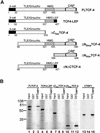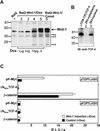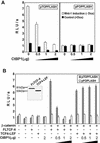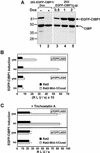HMG box transcription factor TCF-4's interaction with CtBP1 controls the expression of the Wnt target Axin2/Conductin in human embryonic kidney cells
- PMID: 12711682
- PMCID: PMC154232
- DOI: 10.1093/nar/gkg346
HMG box transcription factor TCF-4's interaction with CtBP1 controls the expression of the Wnt target Axin2/Conductin in human embryonic kidney cells
Abstract
Members of the Tcf/Lef family of the HMG box transcription factors are nuclear effectors of the Wnt signal transduction pathway. Upon Wnt signaling, TCF/LEF proteins interact with beta-catenin and activate transcription of target genes, while, in the absence of the Wnt signal, TCFs function as transcriptional repressors. All vertebrate Tcf/Lef transcription factors associate with TLE/Groucho-related co-repressors, and here we provide evidence for an interaction between the C-terminus of the TCF-4 HMG box protein and the C-terminal binding protein 1 (CtBP1) transcriptional co-repressor. Using Wnt-1-stimulated human embryonic kidney 293 cells, we show that CtBP1 represses the transcriptional activity of a Tcf/beta-catenin-dependent synthetic promoter and, furthermore, decreases the expression of the endogenous Wnt target, Axin2/Conductin. The CtBP1-mediated repression was alleviated by trichostatin A treatment, indicating that the CtBP inhibitory mechanism is dependent on the activity of histone deacetylases.
Figures








Similar articles
-
TCF: Lady Justice casting the final verdict on the outcome of Wnt signalling.Biol Chem. 2002 Feb;383(2):255-61. doi: 10.1515/BC.2002.027. Biol Chem. 2002. PMID: 11934263 Review.
-
The Yin-Yang of TCF/beta-catenin signaling.Adv Cancer Res. 2000;77:1-24. doi: 10.1016/s0065-230x(08)60783-6. Adv Cancer Res. 2000. PMID: 10549354 Review.
-
Wnt/beta-catenin/Tcf signaling induces the transcription of Axin2, a negative regulator of the signaling pathway.Mol Cell Biol. 2002 Feb;22(4):1172-83. doi: 10.1128/MCB.22.4.1172-1183.2002. Mol Cell Biol. 2002. PMID: 11809808 Free PMC article.
-
Activation of AXIN2 expression by beta-catenin-T cell factor. A feedback repressor pathway regulating Wnt signaling.J Biol Chem. 2002 Jun 14;277(24):21657-65. doi: 10.1074/jbc.M200139200. Epub 2002 Apr 8. J Biol Chem. 2002. PMID: 11940574
-
Regulation of lymphoid enhancer factor 1/T-cell factor by mitogen-activated protein kinase-related Nemo-like kinase-dependent phosphorylation in Wnt/beta-catenin signaling.Mol Cell Biol. 2003 Feb;23(4):1379-89. doi: 10.1128/MCB.23.4.1379-1389.2003. Mol Cell Biol. 2003. PMID: 12556497 Free PMC article.
Cited by
-
Wnt Effector TCF4 Is Dispensable for Wnt Signaling in Human Cancer Cells.Genes (Basel). 2018 Sep 1;9(9):439. doi: 10.3390/genes9090439. Genes (Basel). 2018. PMID: 30200414 Free PMC article.
-
Isoform switch of T-cell factor7L2 during mouse heart development.J Mol Cell Cardiol Plus. 2025 May 23;12:100458. doi: 10.1016/j.jmccpl.2025.100458. eCollection 2025 Jun. J Mol Cell Cardiol Plus. 2025. PMID: 40519869 Free PMC article.
-
C-terminal-binding protein directly activates and represses Wnt transcriptional targets in Drosophila.EMBO J. 2006 Jun 21;25(12):2735-45. doi: 10.1038/sj.emboj.7601153. Epub 2006 May 18. EMBO J. 2006. PMID: 16710294 Free PMC article.
-
PR72, a novel regulator of Wnt signaling required for Naked cuticle function.Genes Dev. 2005 Feb 1;19(3):376-86. doi: 10.1101/gad.328905. Genes Dev. 2005. PMID: 15687260 Free PMC article.
-
Evolutionary diversification of the canonical Wnt signaling effector TCF/LEF in chordates.Dev Growth Differ. 2022 Apr;64(3):120-137. doi: 10.1111/dgd.12771. Epub 2022 Feb 3. Dev Growth Differ. 2022. PMID: 35048372 Free PMC article.
References
-
- Cadigan K.M. and Nusse,R. (1997) Wnt signaling: a common theme in animal development. Genes Dev., 11, 3286–3305. - PubMed
-
- Bienz M. and Clevers,H. (2000) Linking colorectal cancer to Wnt signaling. Cell, 103, 311–320. - PubMed
-
- Miller J.R. and Moon,R.T. (1996) Signal transduction through beta-catenin and specification of cell fate during embryogenesis. Genes Dev., 10, 2527–2539. - PubMed
-
- Coates J.C., Grimson,M.J., Williams,R.S., Bergman,W., Blanton,R.L. and Harwood,A.J. (2002) Loss of the beta-catenin homologue aardvark causes ectopic stalk formation in Dictyostelium. Mech. Dev., 116, 117–127. - PubMed
-
- Hobmayer B., Rentzsch,F., Kuhn,K., Happel,C.M., von Laue,C.C., Snyder,P., Rothbacher,U. and Holstein,T.W. (2000) WNT signalling molecules act in axis formation in the diploblastic metazoan Hydra. Nature, 407, 186–189. - PubMed
Publication types
MeSH terms
Substances
LinkOut - more resources
Full Text Sources
Other Literature Sources
Molecular Biology Databases
Research Materials
Miscellaneous

